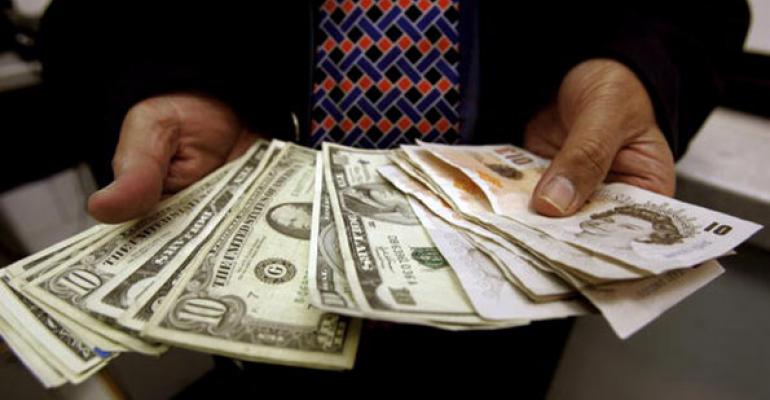In its recently completed third quarter, McDonald’s Corp. said that its revenues fell by $372 million, or 5 percent. But it wasn’t because the company sold fewer hamburgers.
The problem was the dollar.
The strong U.S. dollar has been a burden on many company earnings, Yum! Brands Inc., Domino’s Pizza Inc., Krispy Kreme Doughnuts, included.
At a big global multinational like McDonald’s, the impact of the dollar can be big. McDonald’s said that, without that foreign currency translation, sales would have increased 7 percent in the period.
McDonald’s investors dismissed the news of the revenue decline that day, largely because they’d grown accustomed to such swings, but also because the company’s sales appeared to have turned around following a three-year slump. Still, the strong dollar is hurting sales and profits at any restaurant chain that does a lot of business outside of U.S. borders.
A strong dollar is good for Americans who travel to other countries, but it is bad for U.S. companies that do business abroad. The dollar began strengthening in July of last year and, though it has fallen from its peak strength of this past spring, it’s still 21 percent stronger than it was back then, according to the U.S. Dollar Index, which measures the strength of the dollar against a basket of foreign currencies.
A strong dollar is good for Americans who travel to other countries but it is bad for U.S. companies that do business there. A strong dollar hurts U.S. companies doing business abroad because the currency they receive isn’t worth as much as it used to be worth. And that hurts comparisons. For instance, a year ago the Euro was worth $1.26. Today, that Euro is worth $1.13. So the revenue generated in Europe is worth 10 percent less now than it was at that time.
To be sure, the dollar gains or loses value year after year and companies keep track of it. As a result, most multinational companies typically note the impact that exchange rates have on sales and profits.
The difference this year is that the dollar has been strong against most of the world’s currencies, including the most traded currencies. The dollar’s comparative strength intensified the impact that exchange rates have on sales and profits.
In August, China devalued its currency, the yuan, and the value of that denomination fell 3 percent that month.
The dollar is also stronger when compared with the Russian ruble, the Brazilian real, the British pound and the Japanese yen, among others.
In addition, restaurant chains have been aggressively expanding in foreign markets, and even smaller chains are adding units overseas. A number of U.S.-based chains now have more locations outside of this country, including McDonald’s, Yum Brands and Domino’s. As a result, these companies are more exposed than they used to be.
Lousiville, Ky.-based Yum has been aggressively expanding its KFC, Taco Bell and Pizza Hut units in other countries for decades. It has been notably aggressive in China.
Yum said that foreign currency translation hurt its earnings by 6 percent in the company’s third quarter. Currency translation hurt operating profit in the quarter by $29 million. In China alone, the yuan devaluation hurt profits by $4 million in the quarter.
Yum executives said the devaluation was unexpected and that the impact wasn’t just limited to profits. They said it kept some people from dining out at Pizza Hut, which in China is a casual-dining restaurant.
“The surprise currency devaluation and overall softer economic conditions are weighing more heavily on higher ticket casual dining sector in China,” CFO Pat Grismer said on the company’s earnings call.
The impact of foreign currency exchange
Another aggressive international concept is Ann Arbor, Mich.-based pizza chain Domino’s, which has 7,000 locations of its 12,000 units overall in foreign markets.
Global retail sales for Domino’s increased 6.1 percent in the company’s recently completed third quarter. Without foreign currency issues, those sales would have increased 15.2 percent.
Foreign currency has hurt revenues by $13.5 million so far this year, Domino’s executives said, and the chain now estimates that foreign currency rates could impact revenues by as much as $20 million for the full year — far higher than the company initially expected.
“Foreign currencies have negatively impacted us to a much greater degree than any of us had expected,” CFO Jeff Lawrence said on the company’s earnings call. He added that the company’s global retail sales would have been more than $1 billion higher if Domino’s had used 2011 exchange rates.
It’s not just big chains, either. Winston-Salem, N.C.-based Krispy Kreme Doughnuts, which has 758 of its 1,045 units in foreign markets, said that sales at its international locations rose 3.4 percent in the company’s second quarter ended Aug. 2. Without foreign exchange rates, they would have risen 16.1 percent.
McDonald’s Corp., based on Oak Brook, Ill., has 36,000 locations worldwide, 22,000 of which are outside of the United States. Foreign currency translation can swing sales and profits by millions of dollars — and frequently does.
Last year, for instance, the company said that foreign currency translation lowered earnings per share by 12 cents.
This year? The strong dollar hurt earnings per share by 39 cents. The company has another quarter left.
The good news is that these swings come and go.
“If currencies moderate over time,” Lawrence said, “this could eventually become a nice tailwind for us.”
Contact Jonathan Maze at [email protected]
Follow him on Twitter: @jonathanmaze





